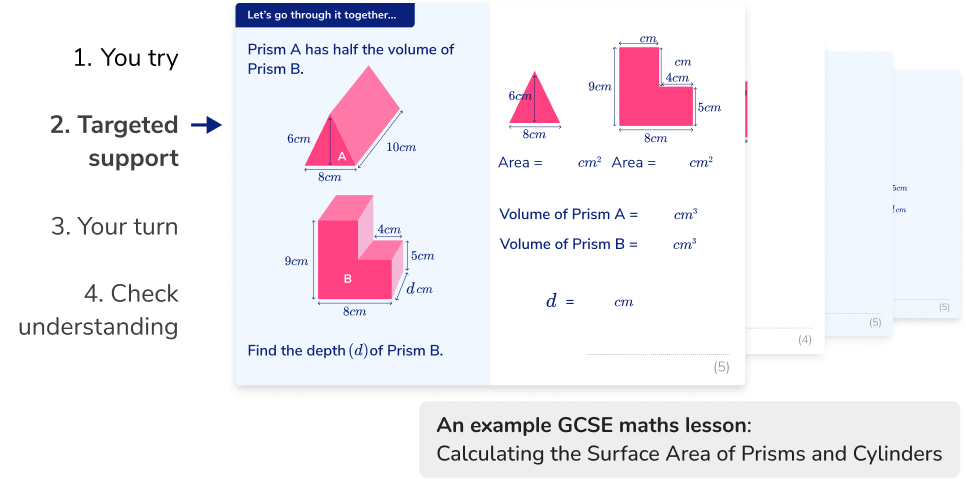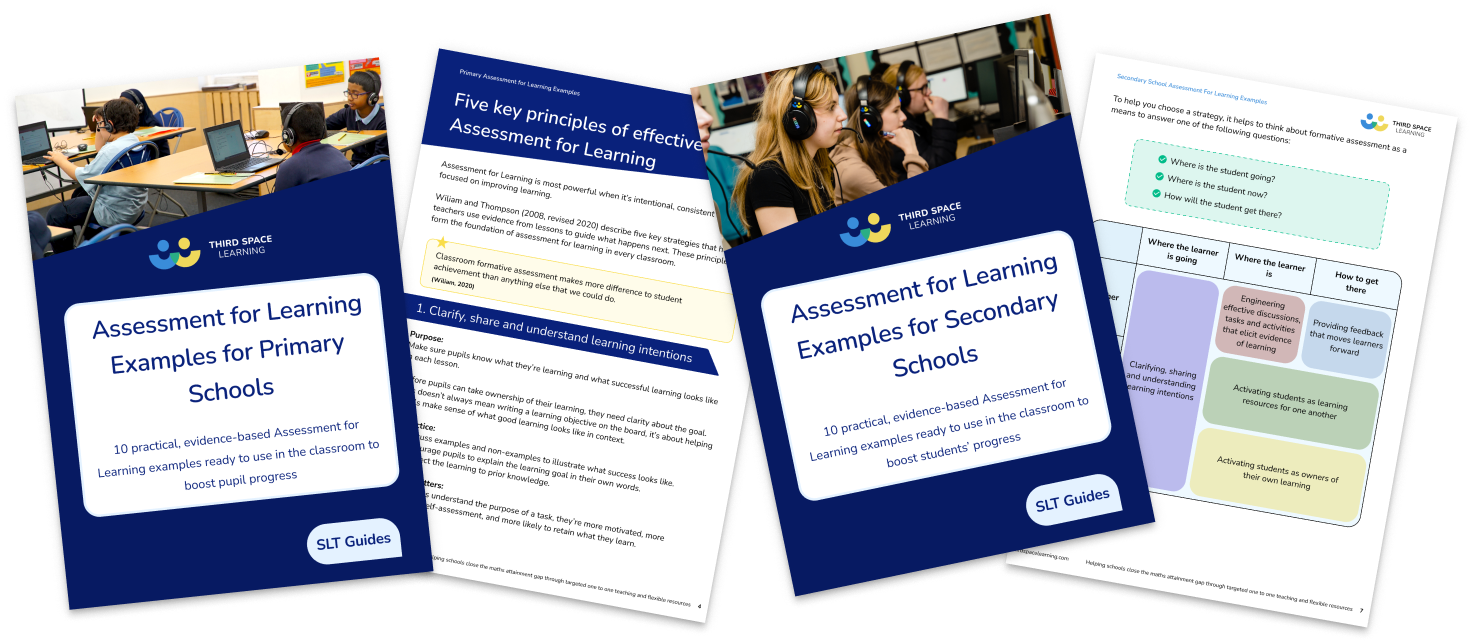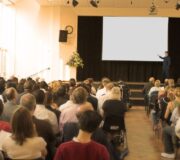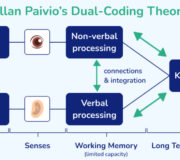The 6 Best Assessment For Learning Strategies And How To Make Them Work In Your Classroom
Our online tutors exist to supplement what you are doing in class; they are trained in and deploy the same assessment for learning strategies that you use every day.
Here we look at the 6 assessment for learning strategies that our tutors use most often in the one to one tutoring sessions and share how you can integrate these strategies into your classroom teaching.
What are assessment for learning strategies?
Assessment for learning strategies are the range of strategies that teachers draw upon to assess learning within their teaching practice. These strategies aim to gather data on a student’s current level of understanding and any misconceptions. Teachers then use this information to adjust their teaching strategies, give feedback or even re-teach to drive learning forward.
Adopting a range of approaches is key to ensuring assessment for learning (AfL) is successful and has the desired impact within the classroom.
Assessment for learning isn’t new, it first gained popularity in the 1990s. Researchers, such as Paul Black and Dylan Wiliam, highlighted the benefits of formative assessment for learning strategies vs summative assessment – assessment of learning.
Assessment for Learning Examples
A quick guide to the 10 most effective Assessment for Learning strategies with examples in context to show how and where to use them. Includes advice on next steps for adapting your teaching.
Download Free Now!Here we explore six assessment for learning strategies, concrete examples and best practice recommendations for implementing them.
- Direct observation
- Questioning
- Feedback
- Self-assessment
- Peer-assessment
- The formative use of summative assessment
Why use assessment for learning strategies?
Assessment for learning is a key component of the teaching and learning process. Using a range of strategies provides teachers with the information necessary to determine where the children are in their learning. It also helps to identify any gaps which may prevent pupil progress.
AfL also enables children to take an active role in their learning. With a greater understanding of the aims, children can understand what is needed to achieve success and can play a role in moving their learning forward.
If these assessment checks aren’t made, teachers and students will not have an accurate picture and understanding of where they are or what they need to do to progress.
Remember that formative assessment is often considered a continuous process of finding out what the student knows, evidencing this (ie ‘how do you know that they know it), understanding where they need to go next and providing them with the support to get there.

Meet Skye, the voice-based AI tutor making maths success possible for every student.
Built by teachers and maths experts, Skye uses the same pedagogy, curriculum and lesson structure as our traditional tutoring.
But, with more flexibility and a lower cost, schools can scale online maths tutoring to support every student who needs it.
Watch Skye in actionWhat impact do these assessment for learning strategies have on the learner?
Several researchers found that adopting a range of assessment for learning strategies can significantly impact the learner.
Black and Wiliam published their review of assessment practices in their 1998 publication, Inside the Black Box: Raising Standards Through Classroom Assessment. Through this research, they investigated what was happening in classrooms and discovered that students who are regularly formatively assessed achieve much better results than those who do not.
John Hattie ranked feedback strategies 10th out of 150 factors that have significant improvements in learner outcomes, particularly if the strategies involved feedback about the learner’s work.
6 assessment for learning strategies
There are six key assessment for learning strategies. Here, we focus on what these are and provide some examples on how each strategy can be incorporated into everyday learning within the classroom:
1. Direct observation
With direct observation, the teacher observes small groups or pairs of children working on a specific question posed deliberately to assess what the children know. It can be implemented at any point during the lesson.
This form of assessment requires no direct participation from the students who continue the lesson and task as normal, often unaware they are in fact carrying out an assessment activity.
An example of this form of assessment is starting a maths lesson with a challenge, with no prior teaching. This is the perfect opportunity to observe what students already know and how they are able to apply their previous learning to cope with a new situation.
For instance, you might present a problem involving fractions and observe how students approach the problem. Do they attempt to visualise the fractions using diagrams? Do they try to find a common denominator? By observing their strategies, you can gauge their level of understanding and identify any misconceptions.
ASSESSMENT OPPORTUNITIES AT EACH STAGE OF THE LESSON
At Third Space Learning, Skye, our voice-based AI one-to-one tutor, uses formative assessment at the start of the maths lesson as well as continuously through it to make sure that the intervention is truly targeted and focused on each individual pupil’s learning needs. Depending on the pupil’s needs, this might mean beginning with guided, step-by-step solutions and explanations or moving straight to independent practice and more challenging questions if they’re confident.
READ MORE: Third Space Learning

2. Questioning
Questioning can be an effective assessment tool in a teacher’s armoury when it is used well. It enables teachers to uncover and address any misunderstandings that students have.
It also allows teachers to gauge the extent of students’ knowledge and comprehension. Strategic questioning often includes open-ended questions, which stimulate critical thinking and reasoning, whereas closed-ended questions are limited to prompting straightforward recall.
Examples of open-ended question prompts include:
- Can you describe…?
- Why does X matter?
- What would happen if…?
- How might you…?
Questions need to encourage children to think critically and share their ideas, as opposed to always writing them down.
Effective questioning enables teachers to:
- provide instant feedback to pupils;
- address misconceptions;
- close gaps as they arise.
EXAMPLES OF QUESTIONING
- Hinge questions
- Round the room individual questioning
- Quizzes and polls (ideally diagnostic!)
- Use of mini whiteboards to answer questions
3. Feedback
Of course, for assessment for learning to be effective and have an impact, observing and asking questions are not enough on their own.
The information the teacher gathers during this stage needs to be used well to identify where the learners are, any misconceptions they have and the next steps they may need to take. Effective feedback ensures assessment for learning strategies impact student understanding and learning outcomes.
There are two main types of feedback:
- evaluative (grades or brief comments)
- descriptive feedback (helpful comments and next steps)
Descriptive feedback provides children with more detailed and useful information than evaluative feedback or single word judgements. It contains specific information on what they have done correctly, but also how to improve their learning.
Research has found the impact of descriptive feedback to be greater than simply marking answers right or wrong. It is particularly beneficial when given verbally ‘in the moment’. The idea is that the teacher can clarify the learning criteria and then highlight the steps a pupil needs to take to work towards it.
One example of this form of feedback is when teachers provide feedback that addresses what they’ve done well (which could be as simple as they tried to work independently) and then also gives actionable points to work on with next steps should be clear. With verbal feedback this is even more important so they can action it straight away.
EXAMPLES OF DESCRIPTIVE FEEDBACK
Here are some examples of effective descriptive feedback in a maths context:
“Great job using the BODMAS rule to simplify the expression! Next time, focus on keeping your working neat and organised so it’s easier to spot any errors.”
“I like how you’ve drawn a diagram to represent the problem. To improve, try labelling your diagram with the key information from the question to help you solve it.”
“Your answer shows a good understanding of the concept. Now, let’s think about how you can apply this to more complex problems.”
Primary school teachers sometimes talk about two stars and a wish in this context, where the wish is what the next steps need to be. This framework can help structure your feedback in a positive and actionable way.
RELATED ARTICLE: Whole class feedback to reduce workload
4. Self-assessment
Self-evaluation and self-assessment strategies are important for ensuring AfL is impactful. Giving children greater involvement with their learning and learning tasks promotes metacognition (the ability to think about their thinking), self-esteem, and builds collaborative learning skills.
EXAMPLES OF SELF-ASSESSMENT
An example of self-assessment can be students doing their own review of their answers on a maths paper or set of maths questions to establish the topics they have been able to do and the ones they’ve struggled with.
- Learning logs: Students keep a record of their learning, reflecting on what they’ve understood well and areas they need to work on; it also helps for them to record their learning goals and learning intentions here.
- Exit tickets: At the end of a lesson, students write down one thing they learned, one thing they found challenging, and one question they still have.
It’s worth noting here that we do not encourage teachers to recommend students use the popular Traffic Light system of self-assessment as too often these reflect a student’s confidence in what they think they know. The actual picture may be very different.
5. Peer-assessment
Peer assessment is a useful form of AfL as children often are more accepting of observations about their work when made by a peer, compared to when made by a teacher. The language used by their peers can make it more accessible to them. This process needs clear guidelines and training so that children understand how to provide critical analysis of each other’s work without making it personal. It is obviously reliant on there not being conflict and students working well together.
EXAMPLES OF PEER ASSESSMENT
- Peer marking: Students mark each other’s work using a set of criteria or a mark scheme. Ideally the work should be anonymised (or even a prepared work example).
- Pair problem-solving: Students work in pairs to solve a maths problem, explaining their thinking to each other and providing feedback.
- Two stars and a wish: Primary school teachers quite often use this format for structuring their feedback.
6. The formative use of summative assessment
There is a common misconception that formative assessment is made up of quizzes and polls, whilst summative assessments are exams and tests. But it is important to note that it is not the form of the assessment that makes it either formative or summative, but instead is how the feedback is used.
This means that traditionally summative assessments can be reworked to be used formatively.
EXAMPLES OF FORMATIVE USE OF SUMMATIVE ASSESSMENT
- DIRT (Designated Improvement and Reflection Time) on tests and exams: Allow pupils to review their tests and receive detailed feedback and activities to complete to improve their answers.
- Use worked examples: following the completion of a series of questions or a test, identify incorrectly answered questions and then provide them with clear worked examples for related questions. Ask pupils to work through the examples and help them to identify where they previously went wrong. Then provide the pupils with another opportunity to practice with a similar question
READ MORE: Formative and summative assessment
Good practice when integrating assessment for learning strategies into your classroom practice
- Make sure success criteria and learning objectives are not only clear, but also understood by pupils.
- Use a range of questioning strategies to deepen understanding at all stages of the lesson.
- Ensure feedback is clear and has an impact on students’ performance.
- Include a range of strategies for enabling students to be active participants in their own learning, through peer and self-assessment.
- Make formative use of summative tests to highlight gaps and learning needs, and allow students to directly impact their progress.
- Use diagnostic questions to pinpoint the precise misconceptions each student may have.
- Evaluate the impact of any assessment for learning strategies you employ. If they are not having an impact, look at what could be done to ensure they do.
- Senior leaders must ensure that teachers know how to implement AfL successfully into their learning environment, through ongoing support and effective professional development.
Challenges of implementing assessment for learning strategies
While assessment for learning strategies can be incredibly beneficial for student learning, implementing them in the classroom can come with some challenges. Here are a few common challenges teachers may face and some practical tips for overcoming them:
- Time constraints
Incorporating AfL strategies into your lessons can be time-consuming, especially when you’re first starting out. It’s important to remember that you don’t need to use all the strategies at once. Start small and gradually build up as you and your students become more comfortable with the process.
Tip: Plan your AfL strategies in advance and allocate specific time for them in your lesson plans. This will help you stay on track and ensure that assessment is an integral part of your teaching, not an afterthought.
- Student resistance
Some students may be resistant to AfL strategies, particularly if they’re used to a more traditional, teacher-led approach. They may feel uncomfortable with self-assessment or peer-assessment, or they may not see the value in engaging with feedback.
Tip: Introduce AfL strategies gradually and explain their purpose to your students. Help them understand how these strategies can benefit their learning and make the process engaging and interactive. Celebrate your student’s achievement, progress and efforts to encourage buy-in.
- Ensuring consistency
It can be challenging to ensure that AfL strategies are being used consistently across the school, particularly if not all teachers are on board or have the same level of understanding.
Tip: Provide training and support for all staff to ensure everyone understands the importance of AfL and how to implement the strategies effectively. Encourage collaboration and sharing of best practices among teachers.
- Dealing with misconceptions
Through AfL strategies, you may uncover misconceptions that students have about certain concepts. Addressing these misconceptions can be challenging, particularly if they’re deeply ingrained.
Tip: Use the information you gather from AfL to plan targeted interventions and support. Break down the misconception into smaller parts and provide clear explanations and examples to help students develop a better understanding.
- Managing data
Implementing AfL strategies can generate a lot of data about student understanding and progress. Managing this data and using it effectively can be a challenge.
Tip: Use a simple tracking system to record student progress and identify areas for improvement. This could be as simple as a spreadsheet or a dedicated assessment app. Regularly review the data with your students and use it to inform your planning and teaching.
- Maintaining momentum
It can be easy to start strong with AfL strategies but then let them fall by the wayside as other priorities take over. Maintaining momentum and consistency can be a challenge.
Tip: Make the use of assessment for learning a regular part of your classroom routine and prioritise it in your planning. Set goals for yourself and your students and regularly review progress. Celebrate successes and learn from challenges to keep the momentum going.
Assessment for learning strategies are integral to good teaching and learning
Assessment for learning strategies are not just a set of isolated techniques; they are part of an integrated approach to teaching that puts student progress at the centre. Using these strategies should be embedded in teaching practice across the school and not as an add-on. And, the greater number of strategies you use, the greater the impact.
If teachers only carry out half of the assessment for learning process, for example, capturing and recording information gathered from assessment but do not use it to improve student learning, it is a meaningless tick-box exercise.
This means taking the time to analyze student responses, identify areas of strength and weakness, and adapt teaching to provide targeted support where it’s needed most.
By incorporating these strategies into your maths teaching, you can create a better assessment for learning environment that supports learner progress and understanding.
Remember, the key is to use the information you gather from these AfL strategies to adapt your teaching and provide targeted support to your students.
DO YOU HAVE STUDENTS WHO NEED MORE SUPPORT IN MATHS?
Skye – our AI maths tutor built by teachers – gives students personalised one-to-one lessons that address learning gaps and build confidence.
Since 2013 we’ve taught over 2 million hours of maths lessons to more than 170,000 students to help them become fluent, able mathematicians.
Explore our AI maths tutoring or find out about maths intervention programmes for your school.







